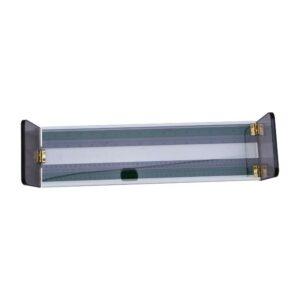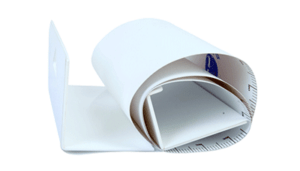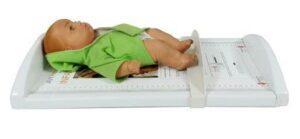Infantometers play a pivotal role in ensuring the accurate monitoring of the growth and development of infants. As a parent or healthcare professional, understanding the importance of Infantometers and how to use them effectively is crucial. In this blog, we will delve into the world of Infantometers, exploring their various types, advantages over traditional growth monitoring methods, and expert recommendations. We will also provide valuable insights on selecting the perfect Infantometer, the significance of calibration, best practices for usage, and addressing common concerns through FAQs. Moreover, we’ll highlight the benefits of early detection with Infantometers and weigh the pros and cons of incorporating them into infant growth
The Importance of Infantometers
Infantometers hold significant importance in the field of healthcare, particularly in monitoring the growth and development of infants. These specialised measuring devices offer several key benefits that contribute to the overall well-being of babies. Let’s explore the importance of Infantometers
- Accurate Measurement: Infantometers provide precise measurements of an infant’s length or height. This accuracy is crucial for tracking growth patterns over time, identifying potential growth issues, and ensuring appropriate development milestones are met. Accurate measurements form the foundation of effective healthcare management for infants.
- Early Detection of Growth Issues: Infantometers play a vital role in the early detection of growth abnormalities or delays. By regularly monitoring an infant’s growth trajectory, healthcare professionals can identify potential concerns at an early stage. Early detection allows for timely intervention and appropriate medical attention, increasing the chances of better outcomes and minimising long-term complications.
- Objective Monitoring: Infantometers offer an objective method of measuring an infant’s growth. Unlike subjective assessments, such as visual estimation, using Infantometers provides consistent and reliable data. This objectivity helps healthcare professionals make informed decisions based on accurate measurements, ensuring comprehensive and personalised care for each baby.
- Data-driven Decision Making: The precise measurements obtained from Infantometers enable healthcare professionals to analyse growth trends, compare data against standardised growth charts, and make data-driven decisions. This data-driven approach helps identify deviations from the normal growth pattern, allowing for targeted interventions and personalised treatment plans.
- Tracking Development Milestones: Infantometers assist in monitoring an infant’s growth in relation to established developmental milestones. By regularly measuring length or height, healthcare providers can assess whether a baby is progressing appropriately in terms of physical growth and development. Tracking milestones helps identify potential developmental delays and enables early intervention for optimal outcomes.
- Facilitating Research and Population Health: Infantometers’ data contributes to research studies and population health monitoring. Aggregated growth data obtained from Infantometers helps identify population trends, assess the impact of interventions or healthcare policies, and contribute to the advancement of paediatric healthcare knowledge.
In summary, Infantometers are essential tools for accurately monitoring the growth and development of infants. They enable healthcare professionals to detect growth abnormalities early, make data-driven decisions, track developmental milestones, and contribute to research efforts. By utilising Infantometers, healthcare providers can optimise the care and well-being of infants, ensuring they reach their full growth potential and thrive in their early years.
Understanding Different Types of Infantometers
Infant Metres are specialised devices used for measuring the length or height of infants. They come in various types, each with unique features and benefits. Understanding the different types of Infantometers can help healthcare professionals and parents choose the most suitable option for accurate and convenient measurements. Let’s explore these types
- Digital Infantometers: Digital Infantometers utilise advanced technology, such as infrared sensors or ultrasound, to provide precise measurements. They often have a digital display that shows the length or height reading. Digital Infantometers are user-friendly, quick, and offer easy-to-read measurements, making them popular in clinical settings.
- Mechanical Infantometers: Also known as manual Infantometers, these devices rely on mechanical mechanisms for measuring an infant’s length or height. They typically consist of a movable headpiece or sliding bar that can be adjusted to fit the baby’s position. Mechanical Infant Metres are durable, cost-effective, and do not require power sources or batteries.
- Wall-Mounted Infantometers: Wall-mounted Infantometers are designed to be permanently installed on a wall. They provide a fixed measurement scale against which an infant’s length or height can be measured accurately. These Infantometers are commonly found in hospitals, clinics, and healthcare facilities where frequent and consistent measurements are required.
- Portable Infant Metres: Portable Infant Metres are lightweight and designed for easy transportation. They are compact in size and often foldable or collapsible, making them convenient for home use or when healthcare professionals need to perform measurements outside of the clinical setting. Portable Infantometers are ideal for mobile healthcare services and home visits.
- Digital Scale-Integrated Infantometers: These Infantometers combine the functionality of a weighing scale with a measuring device. They allow simultaneous measurement of weight and length/height, providing comprehensive growth data. Digital scale-integrated Infantometers are particularly useful for monitoring the growth progress of infants and obtaining comprehensive growth profiles.
- Digital Imaging Infantometers: Digital imaging Infantometers use imaging technology, such as 3D scanning or optical imaging, to capture images of infants and extract accurate measurements digitally. They provide non-contact measurements and are especially beneficial for infants who may have difficulty staying still during measurement. Digital imaging Infantometers offer precise and efficient measurements.
When selecting an Infantometer, consider factors such as accuracy, ease of use, durability, and specific requirements for your healthcare or home setting. Each type of Infantometer has its advantages and suitability for different scenarios, so choose the one that best fits your needs and ensures accurate measurements of an infant’s length or height.
Infantometers vs. Traditional Growth Monitoring
Infant Metres have revolutionised the way we monitor the growth and development of infants. Let’s compare Infantometers with traditional methods of growth monitoring to understand their advantages
- Accuracy: Infantometers provide highly accurate measurements of an infant’s length or height. Traditional methods, such as using a tape measure or visual estimation, may lead to variations and subjective judgments. Infantometers offer precise and objective measurements, ensuring reliable data for tracking growth progress.
- Consistency: Infantometers offer consistent measurements over time. With traditional methods, different healthcare providers may have varying techniques or interpretations, leading to inconsistencies in the recorded measurements. Infantometers eliminate this variability and provide consistent data for accurate growth tracking.
- Ease of Use: Infantometers are designed to be user-friendly, making it easy for healthcare professionals and parents to measure an infant’s length or height. Traditional methods may require specific training or expertise to ensure accurate measurements. Infantometers simplify the process and allow for quick and convenient measurements.
- Efficiency: Infantometers offer efficient measurements, saving time and effort compared to traditional methods. With traditional methods, measuring an infant’s length or height can be a time-consuming process that requires multiple steps. Infantometers streamline the process, providing instant measurements with minimal hassle.
- Objective Data: Infantometers provide objective data that can be compared against standardised growth charts. This allows healthcare professionals to assess an infant’s growth patterns accurately and identify any deviations or concerns. Traditional methods may rely on subjective visual estimation, which can be prone to errors and inaccuracies.
- Data Tracking: Infantometers often come with built-in features or digital interfaces that allow for easy tracking and recording of growth data. This simplifies the monitoring process, enables efficient data management, and facilitates comprehensive growth analysis. Traditional methods may involve manual record-keeping, which can be time-consuming and prone to errors.
Overall, Infantometers offer numerous advantages over traditional methods of growth monitoring. They provide accurate, consistent, and objective measurements, simplify the measurement process, and enable efficient data tracking and analysis. By adopting Infantometer, healthcare professionals and parents can ensure precise and reliable monitoring of an infant’s growth and development.
A Blog for Selecting the Perfect Infantometer
Choosing the right Infantometer is crucial for accurate and reliable measurements of an infant’s length or height.
- Accuracy: Look for an Infantometer that offers high accuracy in measurements. Check for features such as precision-engineered scales, digital technology, or advanced sensors that ensure precise and consistent readings.
- Ease of Use: Consider the ease of use of the Infantometer. Look for features like clear measurement markings, user-friendly controls, and adjustable components to accommodate infants of different sizes comfortably.
- Durability: Choose an Infantometer made from durable materials that can withstand frequent use. Consider factors such as sturdiness, resistance to wear and tear, and easy maintenance to ensure long-lasting performance.
- Safety: Prioritise the safety of the infant during measurement. Look for Infantometers with features like rounded edges, smooth surfaces, and secure head supports to prevent any harm or discomfort to the baby.
- Portability: If you require a portable Infantometer for home visits or mobile healthcare services, consider its portability. Look for lightweight and compact designs that are easy to transport without compromising on accuracy and functionality.
- Additional Features: Some Infantometers come with additional features that enhance usability, such as digital displays, memory functions, growth tracking software, or integration with electronic health records. Evaluate these features based on your specific needs and preferences.
- Quality and Brand Reputation: Opt for Infantometers from reputable brands known for their quality and reliability. Read reviews, seek recommendations from healthcare professionals, and choose a brand that has a good track record in providing accurate and dependable measuring devices.
- Budget Considerations: Determine your budget range and find an Infantometer that offers the desired features and accuracy within your budget. Balance cost with quality and functionality to make an informed decision.
By considering these factors, you can select an Infantometer that meets your requirements for accuracy, ease of use, durability, safety, and portability. Investing in the perfect Infantometer ensures accurate growth monitoring and contributes to the overall well-being of infants.
The Importance of Calibrating Infantometers
Calibrating Infantometers is a crucial step in ensuring accurate and reliable measurements of an infant’s length or height. Here’s why calibrating Infantometers is important
- Accuracy: Calibrating Infantometers helps maintain their accuracy. Over time, factors such as wear and tear, temperature variations, or mechanical adjustments can affect the measurement precision of Infantometers. Regular calibration ensures that the device is properly adjusted to provide accurate measurements, eliminating any potential errors.
- Consistency: Calibrated Infantometers offer consistent results. When Infantometers are calibrated, they are aligned with standardised measurement standards. This consistency allows for reliable tracking of an infant’s growth over time and ensures that measurements are comparable and meaningful.
- Quality Assurance: Calibrating Infantometers serves as a quality assurance measure. It provides confidence that the measurements obtained are reliable and trustworthy. In healthcare settings, where accurate growth monitoring is vital for diagnosing and managing conditions, calibration ensures the integrity of the data collected.
- Compliance with Standards: Many healthcare institutions and regulatory bodies require Infantometers to be calibrated regularly to comply with standards and guidelines. Adhering to these standards ensures that healthcare providers meet the necessary requirements for accurate growth monitoring and maintain the highest level of care for infants.
- Patient Safety: Calibrated Infantometers contribute to patient safety. Accurate measurements are essential for identifying potential growth abnormalities or delays, which can have significant implications for an infant’s health and well-being. By calibrating Infantometers, healthcare professionals can make informed decisions and provide appropriate interventions promptly.
Calibrating Infantometer should be performed at regular intervals as recommended by the manufacturer or regulatory guidelines. It is a critical step in maintaining the accuracy and reliability of these measuring devices, ultimately leading to better healthcare outcomes for infants.
Top Tips for Using Infantometers Effectively
Using Infantometers effectively is essential to obtain accurate and consistent measurements of an infant’s length or height. Here are some top tips for using Infantometers effectively
- Prepare the Infant: Ensure that the infant is calm, comfortable, and in a relaxed position before taking measurements. Minimise any distractions or discomfort that may affect the infant’s position during measurement.
- Positioning: Position the infant correctly for accurate measurements. Ensure that the infant’s head, back, and heels are aligned against the measuring surface of the Infantometer. Gently hold the infant in place, avoiding excessive pressure that may alter the measurement.
- Take Multiple Measurements: To ensure accuracy, take multiple measurements and calculate the average. Infants may squirm or move during the process, leading to slight variations in readings. Taking multiple measurements minimises errors and provides a more reliable result.
- Read the Measurements Carefully: Pay close attention to the measurement markings or digital display on the Infantometer. Read and record the measurement accurately, noting any decimal points or units of measurement (e.g., centimetres or inches).
- Record and Track Growth Data: Maintain a systematic record of the infant’s growth measurements. Use growth charts or digital tracking tools to monitor the infant’s growth progress over time. Regularly update the growth data to detect any deviations or concerns.
- Clean and Maintain Infantometers: Keep Infantometers clean and well-maintained to ensure accurate measurements. Follow the manufacturer’s guidelines for cleaning and maintenance, and regularly inspect the device for any signs of wear or damage.
- Calibration: Regularly calibrate Infantometers as per the manufacturer’s instructions or regulatory requirements. Calibration ensures the accuracy and reliability of the device, contributing to precise measurements.
By following these tips, healthcare professionals and parents can optimise the use of Infantometer, obtain accurate measurements, and monitor an infant’s growth effectively.
Early Detection with Infantometers
Early detection of growth issues is crucial for ensuring timely interventions and promoting healthy development in infants. Infantometers play a vital role in facilitating early detection through accurate and consistent measurements. Here’s why early detection with Infantometers is essential:
- Identification of Growth Abnormalities: Infantometers allow healthcare professionals to track an infant’s growth progress accurately. By comparing the measurements against standardised growth charts, any deviations or abnormalities can be identified early on. Early detection enables timely investigation and intervention if necessary.
- Monitoring Developmental Milestones: Infantometers not only measure an infant’s length or height but also provide insights into overall development. Consistent growth patterns are indicative of healthy development, while significant deviations may signal potential developmental delays or health concerns. Early detection allows for early intervention and support for optimal development.
- Prevention of Long-Term Complications: Certain growth issues, if left undetected and untreated, can lead to long-term complications. By using Infantometers for early detection, healthcare professionals can identify and address growth concerns promptly, potentially preventing future complications and improving outcomes for infants.
- Tailored Interventions: Early detection with Infantometers allows for personalised and targeted interventions based on the specific growth concerns identified. Healthcare professionals can develop customised care plans, provide appropriate nutritional guidance, or refer infants for specialised evaluations if needed.
- Peace of Mind for Parents: Early detection provides reassurance and peace of mind for parents. By monitoring an infant’s growth using Infantometers, parents can actively participate in their child’s healthcare journey and address any concerns promptly. Early interventions can alleviate parental anxiety and contribute to the overall well-being of both infants and their caregivers.
Infantometer serve as valuable tools for early detection, enabling healthcare professionals to identify potential growth issues and provide timely interventions. Early intervention leads to better outcomes and sets the foundation for healthy growth and development in infants.
Pros and Cons of Using Infantometers
Infantometer offer numerous benefits for accurate growth monitoring in infants. However, it’s important to consider the pros and cons before incorporating them into your practice. Here are some advantages and disadvantages of using Infantometer
Pros
- Accurate Measurements: Infantometers provide precise length or height measurements, allowing for accurate growth monitoring. This enables healthcare professionals to track an infant’s growth progress and identify potential issues.
- Standardised Comparison: Infantometers use standardised measurement scales and growth charts, facilitating comparisons with established norms. This helps in identifying growth abnormalities and tracking an infant’s development relative to the general population.
- Objective and Reliable: Infantometers offer an objective and reliable method of growth assessment. They minimise subjective biases and errors that may occur with visual estimations or alternative methods of measurement.
- Early Detection: Infantometers aid in the early detection of growth issues, allowing for timely interventions and management. Early identification can lead to better outcomes and prevent long-term complications.
- Monitoring Developmental Milestones: Infantometers not only measure length or height but also provide insights into an infant’s overall development. They help track developmental milestones and ensure healthy growth and progress.
Cons
- Cost: Infantometers can be expensive, especially high-quality and advanced models. This may pose a financial constraint for healthcare facilities or individuals seeking to purchase them.
- Training and Skill Required: Proper training and skill are necessary to use Infantometers correctly. Healthcare professionals and caregivers need to learn the correct positioning techniques and measurement procedures to obtain accurate results.
- Limited Applicability: Infantometers are designed specifically for infants and may not be suitable for older children or adults. Additional equipment may be required for growth monitoring in other age groups.
- Maintenance and Calibration: Infantometers require regular maintenance and calibration to ensure accuracy. This adds to the operational responsibilities and costs associated with their use.
Despite these considerations, the benefits of using Infantometers for accurate growth monitoring outweigh the potential drawbacks. By understanding the pros and cons and addressing any challenges, healthcare professionals can effectively utilise Infantometer to monitor and support an infant’s growth and development.
Infantometers from Leading Indian Manufacturers Infantometers
Infantometer Mat
The Infantometer Mat from Ibis Medical Equipment and Systems Private Limited is a simple yet highly efficient device for measuring the length of neonates. Crafted with flexible PVC material, this Infantometer Mat offers unparalleled convenience and accuracy. Its foldable design ensures easy storage, even in compact spaces, without any loss of functionality. With the Infantometer Mat, healthcare professionals can seamlessly track the growth of infants, enabling early detection of any developmental issues.
AVI’s Infantometer
AVI Healthcare Pvt. Ltd., a renowned manufacturer and global supplier in India, brings you AVI’s Infantometer, a cost-effective and reliable solution for measuring the height of infants. Designed with utmost precision, this Infantometer is widely utilised in hospitals and maternity centres to assess the growth patterns of infants. It comes with a flat, firm, and sturdy structure, ensuring accurate measurements without the need for calibration or complex setup. The double-sided parallel-positioned scale provides easy readability, and its compact design makes it easy to transport.
Infantometer
 VNG Medical Innovation System Pvt. Ltd. introduces the Infantometer as a valuable addition to their maternal care line. This device plays a crucial role in child health surveillance by measuring the growth of infants. With an accurate scale, the Infantometer aids in establishing normal growth patterns and allows for early diagnosis of underlying medical conditions. By recording the growth of infants, healthcare professionals can identify issues such as underweight or overweight, genetic or medical conditions, and nutritional or other health problems.
VNG Medical Innovation System Pvt. Ltd. introduces the Infantometer as a valuable addition to their maternal care line. This device plays a crucial role in child health surveillance by measuring the growth of infants. With an accurate scale, the Infantometer aids in establishing normal growth patterns and allows for early diagnosis of underlying medical conditions. By recording the growth of infants, healthcare professionals can identify issues such as underweight or overweight, genetic or medical conditions, and nutritional or other health problems.
nice 1050
 nice Neotech Medical Systems Pvt. Ltd. presents the nice 1050 Infantometer, a highly reliable tool for measuring the length of infants. It is equipped with a broad, smooth FRP base and features a one-sided sliding adjustment, making it effortless to measure an infant’s length from head to toe. The Infantometer offers precise measurements in centimetres, millimetres, and inches, with gradation provided for easy reading. The lockable foot piece and adjustable head support ensure stability and comfort during the measurement process.
nice Neotech Medical Systems Pvt. Ltd. presents the nice 1050 Infantometer, a highly reliable tool for measuring the length of infants. It is equipped with a broad, smooth FRP base and features a one-sided sliding adjustment, making it effortless to measure an infant’s length from head to toe. The Infantometer offers precise measurements in centimetres, millimetres, and inches, with gradation provided for easy reading. The lockable foot piece and adjustable head support ensure stability and comfort during the measurement process.
conclusion
Infant Metres are essential tools for accurately monitoring the growth and development of infants. They provide precise measurements of height and length, allowing healthcare professionals and caregivers to track important parameters for assessing overall well-being. By using Infantometers, early detection of growth issues becomes possible, leading to better outcomes and improved intervention strategies.
Understanding the different types of Infantometers available in the market is crucial for selecting the right one to meet specific needs. Whether it’s a wall-mounted, portable, or digital variant, Infantometers offer convenience, accuracy, and consistency compared to traditional methods of growth monitoring.
Regular calibration of Infantometers is essential to maintain their accuracy and reliability. Following best practices for using Infantometers, such as proper positioning and creating a comfortable environment, ensures optimal results.
It’s important to weigh the pros and cons of using Infantometers. While they offer advantages such as accuracy and ease of use, there are limitations to consider as well. Understanding these factors helps in making informed decisions and maximising the benefits of Infantometers for monitoring infant growth.




